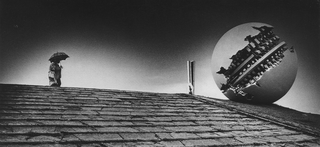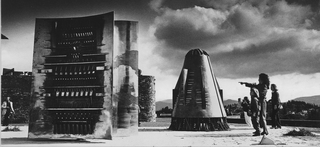Man Ray, Duchamp, Ugo Mulas.
Now Carlo Orsi also tries his hand at photography as a work of art: Arnaldo Pomodoro's sculptures at the Forte di Belvedere in Florence.
The images are events in themselves and represent Pier Luigi Cerri's unique “staging” of the 1984 exhibition. The sculptures, the Michelangelo-esque space, the miraculous backdrop of Florence and the hills of San Miniato are the subjects of a gaze that for the first time ‘discovers’ the secret reasons for “looking” at a work of art.
Being above all forms in space, Arnaldo Pomodoro's sculptures also live off the reflections of the surrounding reality. Their “monumentality” is vertiginous, a disturbing presence, an unstable balance. Carlo Orsi has cleared his memory and privileged the gaze to freely “interpret” the event.
The soft but precise impact has favored the work and its context, highlighting both the infinitely small of the cracks and the infinitely large of the form, in an osmosis of light and shadows. The “view” is captured in flagrante delicto, in its imperceptible becoming. While photographing the sculpture, Carlo Orsi thought of painting. The contrast between light and shadow, the connections and glimpses of vanishing points as spatial “immensity” are characteristic of the view. The viewer is “inside” the field of vision, not ‘outside’ it, as in Canaletto's views. In photography, too, reality is in flux. Its unpredictability introduces the “truth” of the place. What we see amazes us because it is caused more by reflection than by the simple act of taking a picture. Therefore, photography is not a “remedy” for quickly capturing reality. It is an “original evidence” of reality, open to the many questions raised by interpretation. Carlo Orsi is a photographer who, in the words of Roland Barthes, loves the “punctum” of reality (the detail as the whole, and vice versa), because it contains the unpredictability of becoming. The image, in fact, is itself and does not refer to anything else. Hence its visual flagrancy. As Alvin Langdon Coburn said about the relationship between art and time (Camera Work, Alfred Stieglitz's photography magazine, Einaudi 1981), the photographic snapshot is a “comet in the sky of eternity.”
(Italo Mussa, introduction to the book Arnaldo Pomodoro al Forte di Belvedere, texts by Italo Mussa and Giulio Carlo Argan, photographs by Carlo Orsi, De Luca Editore, Rome 1986)
 Back
Back



Social
Contatti
archivio@carloorsi.com